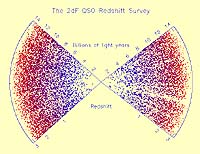
|
|
PREVIOUS ISSUE
MARSDAILY SPACEMART SPACEWAR SPACE TRAVEL TERRADAILY ASTRONAUTIX EMAIL US /ABOUT US SPACEDAILY FORUMS Paid Links |
 Quasar Research Keeps Fundamental Constant - Constant
Quasar Research Keeps Fundamental Constant - Constant Paris - Apr 01, 2004
Paris - Apr 01, 2004Detecting or constraining the possible time variations of fundamental physical constants is an important step toward a complete understanding of basic physics and hence the world in which we live. A step in which astrophysics proves 'useful'. |
|
ACSA Cans Sea Mission 92 ACSA - April 1, 2004
ACSA - April 1, 2004SpaceDaily's Jeffrey Bell takes readers on a humorous look at an early age of planetary exploration that saw voyages of discovery subjected to a court of approval just as difficult as today's mission evaluation committees. Outerplanet Exploration Will Take Much Robotic Teamwork  Milton Keynes - Apr 01, 2004
Milton Keynes - Apr 01, 2004Will swarms of co-operating robots one day be exploring some of the most intriguing worlds in the solar system? James Law, an engineer who is a doctoral student at the Open University, supports the idea that using whole teams of robotic explorers working together offers distinct advantages on remote bodies such as Europa and Titan. |
Molecular Midwives Hold Clues To The Origin Of Life Atlanta - Apr 01, 2004
Atlanta - Apr 01, 2004Adding a small molecule, dubbed a "molecular midwife," researchers increased the rate of DNA formation in a chemical reaction 1,000 fold over a similar reaction lacking a midwife. The discovery is an important step in the effort to trace the evolution of life back to the earliest self-replicating molecules. Hunt For Earth-Like Planets Intensifies  Milton Keynes - Apr 01, 2004
Milton Keynes - Apr 01, 2004An international group of astronomers led by Dr. Jean-Philippe Beaulieu (Institut d'Astrophysique de Paris) and Dr. Martin Dominik (University of St Andrews) are about to continue their hunt for extrasolar planets with an enhanced world-wide telescope network in May this year. |
Life Beneath The Ice Milton Keynes - Apr 01, 2004
Milton Keynes - Apr 01, 2004At present, we know of no worlds beyond our Earth where life exists. However, primitive organisms on our planet have evolved and adapted over billions of years, colonising the most inhospitable places. Wipeout On Titan After Splashdown  Milton Keynes - Apr 01, 2004
Milton Keynes - Apr 01, 2004When the European Huygens probe on the Cassini space mission parachutes down through the opaque smoggy atmosphere of Saturn's moon Titan early next year, it may find itself splashing into a sea of liquid hydrocarbons. Powering Up On Sol For Global Flight  Paris - Apr 01, 2004
Paris - Apr 01, 2004ESA's Technology Transfer Programme is to supply state-of-the-art technologies to assist adventurer Bertrand Piccard's flight around the world in a single-pilot solar-powered aircraft, as the ultimate demonstration of the potential for pollution-free flight. |
Europe Targets Human Exploration Of The Moon And Mars Milton Keynes - Apr 01, 2004
Milton Keynes - Apr 01, 2004These are exciting times for space exploration. For the first time in a generation, human missions beyond Earth orbit are being seriously considered by space agencies on both sides of the Atlantic. Europe has initiated the Aurora programme, with the ultimate aim of landing people on Mars by 2033, while the US has recently redirected its human space activities towards a return to the Moon. MarsExpress Now In Final Commissioning  Paris - Apr 01, 2004
Paris - Apr 01, 2004Since the last status report, the overall operational performance of the spacecraft and payload continued to be satisfactory. Some temporary problems were encountered with the Solid State Mass Memory (SSMM), which are currently under investigation. |
Orbimage Ramps Up Operations And Expands Staff Dulles - Apr 01, 2004
Dulles - Apr 01, 2004Orbimage Inc., the Dulles, VA based satellite imaging company, announced today that it has expanded its staff by approximately 50% to support commercial operations of OrbView-3, its first high-resolution earth observation satellite, and that the company's regional distributor partner in Japan, NTT Data Corporation, has begun routine commercial operations. |
A UK-Led Micro-Mission To The Moons Of Mars? Milton Keynes - Apr 01, 2004
Milton Keynes - Apr 01, 2004The planet Mars possesses two small moons named Phobos (Fear) and Deimos (Terror). Although their existence has been known since their discovery in 1877 and a number of long-range observations have been made by Earth-based telescopes and spacecraft that have visited Mars, the satellites remain only partially studied, particularly Deimos. AeroAstro Awarded SBIR Contract For Reconfigurable Spacecraft  Ashburn, VA � March 31, 2004
Ashburn, VA � March 31, 2004AeroAstro, Inc., a leading provider of small satellites and related technology products, today announced the award of a contract for development of joining techniques for reconfigurable spacecraft based on Vaccro technology. |
| The contents herein, unless otherwise known to be public domain, are Copyright 1995-2004 - SpaceDaily. AFP Wire Stories are copyright Agence France-Presse ESA Portal Reports are copyright European Space Agency. Additional copyrights may apply in whole or part to other bona fide parties. Advertising does not imply endorsement, agreement or approval of any opinions, statements or information provided by SpaceDaily on any web page published or hosted by SpaceDaily. Privacy Statement |